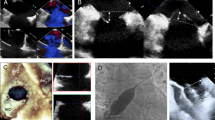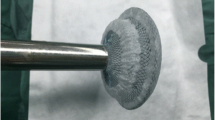Abstract
Transcatheter closure of large atrial septal defects (ASDs) remains controversial. The aim of this study was to evaluate the feasibility and safety of transthoracic echocardiography (TTE)-guided transcatheter closure of large ASDs. Patients with large secundum ASDs (≥ 30 mm) who underwent device closure were retrospectively reviewed. TTE was performed to guide ASD occluder positioning and assess the immediate and long-term outcomes. A total of 60 patients (median age 43.5 years, range 15–78 years) were enrolled in the study. The median ASD size was 35 mm (range 30–42 mm). Mild to moderate pulmonary hypertension was observed in 36 patients (60%). Thirty-one patients (51.7%) had one short rim, and 18 patients (30.0%) had two deficient rims. Placement of the device was successful in 57 patients (95%), and the median device size was 42 mm (range 40–50 mm). Dislodgement of the device occurred in three patients with two deficient rims: a larger device was redeployed in one case, and two patients required surgical repair. During a median follow-up of 37 months (range 6–83 months), no residual shunts, erosion, or embolization were noted, and pulmonary hypertension resolved in 75% of the patients. Thus t vast majority (95%) of large ASDs can be successfully closed percutaneously using the Chinese-made Shanghai Shape Memory Alloy (SHSMA) occluder under TTE guidance. Long-term follow-up showed that transcatheter closure could become a safe and effective alternative to surgery in select large ASDs.




Similar content being viewed by others
References
Carlgren LE (1959) The incidence of congenital heart disease in children born in Gothenburg 1941–1950. Br Heart J 21:40–50
Du ZD, Cao QL, Rhodes J, Heitschmidt M, Hijazi ZM (2002) Choice of device size and results of transcatheter closure of atrial septal defect using the amplatzer septal occluder. J Interv Cardiol 15:287–292
Du ZD, Hijazi ZM, Kleinman CS, Silverman NH, Larntz K; Amplatzer Investigators (2002) Comparison between transcatheter and surgical closure of secundum atrial septal defect in children and adults: results of a multicenter nonrandomized trial. J Am Coll Cardiol 39:1836–1844
Butera G, Romagnoli E, Carminati M, Chessa M, Piazza L, Negura D et al (2008) Treatment of isolated secundum atrial septal defects: impact of age and defect morphology in 1,013 consecutive patients. Am Heart J 156:706–712
Cao C, Wang Z, Huang J, Fan L, Li R, Wang S et al (2016) Feasibility, safety and long-term follow-up of transcatheter closure of secundum atrial septal defects with deficient rims. Cardiology 134:118–126
Rigby ML (1999) The era of transcatheter closure of atrial septal defects. Heart 81:227–228
Huang TC, Hsieh KS, Lin CC, Lee CL (2008) Clinical results of percutaneous closure of large secundum atrial septal defects in children using the Amplatzer septal occluder. Heart Vessels 23:187–192
Li P, Chen F, Zhao X, Zheng X, Wu H, Chen S et al (2012) Occurrence and clinical significance of in-hospital acquired thrombocytopenia in patients undergoing transcatheter device closure for congenital heart defect. Thromb Res 130:882–888
Xu XD, Liu SX, Zhao XX, Qin YW (2014) Comparison of medium-term results of transcatheter correction versus surgical treatment for secundum type atrial septal defect combined with pulmonary valve stenosis. Int Heart J 55:326–330
Xu XD, Ding XY, Liu SX, Bai Y, Zhao XX, Qin YW (2015) Immediate- and medium-term effects of simultaneous percutaneous corrections of secundum type atrial septal defect combined with pulmonary valve stenosis in local anesthesia and without transesophageal echocardiography guidance. J Cardiol 65:32–36
Sun WF, Dong ZF, Gong K, Zhang GP, Cui T, Xia YD et al (2010) Transcatheter closure with use of the SHSMA occluder in 180 patients with congenital heart defects: preliminary results. Tex Heart Inst J 37:531–537
Yang Y, Zhang W, Wu Q, Gao L, Jin W, Zhao T (2016) Transcatheter closure of atrial septal defects without fluoroscopy: a well-established procedure for alternative use in children. EuroIntervention 12:e652–657
Baruteau AE, Petit J, Lambert V, Gouton M, Piot D, Brenot P et al (2014) Transcatheter closure of large atrial septal defects: feasibility and safety in a large adult and pediatric population. Circ Cardiovasc Interv 7:837–843
Bommer W, Weinert L, Neumann A, Neef J, Mason DT, DeMaria A (1979) Determination of right atrial and right ventricular size by two-dimensional echocardiography. Circulation 60:91–100
Swan L, Varma C, Yip J, Warr M, Webb G, Benson L et al (2006) Transcatheter device closure of atrial septal defects in the elderly: technical considerations and short-term outcomes. Int J Cardiol 107:207–210
Guan Z, Qin Y, Zhao X, Ding J, Zheng X, Nguyen V (2008) Transcatheter closure of large atrial septal defects in 18 patients. Clin Cardiol 31:24–27
Boutin C, Musewe NN, Smallhorn JF, Dyck JD, Kobayashi T, Benson LN (1993) Echocardiographic follow-up of atrial septal defect after catheter closure by double-umbrella device. Circulation 88:621–627
King TD, Thompson SL, Steiner C, Mills NL (1976) Secundum atrial septal defect. Nonoperative closure during cardiac catheterization. JAMA 235:2506–2509
Moore J, Hegde S, El-Said H, Beekman R 3rd, Benson L, Bergersen L et al (2013) Transcatheter device closure of atrial septal defects: a safety review. JACC Cardiovasc Interv 6:433–442
Pillai AA, Rangaswamy BV, Selvaraj R, Selvaraj R, Saktheeswaran M, Satheesh S et al (2014) Utility of balloon assisted technique in transcatheter closure of very large (≥ 35 mm) atrial septal defects. Cardiovasc Diagn Ther 4:21–27
Fraisse A, Trivedi KR (2014) Transcatheter closure of atrial septal defects: how large is too large. Cardiovasc Diagn Ther 4:213–214
Varma C, Benson LN, Silversides C, Yip J, Warr MR, Webb G et al (2004) Outcomes and alternative techniques for device closure of the large secundum atrial septal defect. Catheter Cardiovasc Interv 61:131–139
Baumgartner H, Bonhoeffer P, De Groot NM, de Haan F, Deanfield JE, Galie N et al (2010) ESC guidelines for the management of grown-up congenital heart disease (new version 2010). Eur Heart J 31:2915–2957
Warnes CA, Williams RG, Bashore TM, Child JS, Connolly HM, Dearani JA et al (2008) ACC/AHA 2008 guidelines for the management of adults with congenital heart disease: a report of the American College of Cardiology/American Heart Association Task Force on Practice Guidelines (Writing Committee to Develop Guidelines on the Management of Adults With Congenital Heart Disease). Developed in Collaboration With the American Society of Echocardiography, Heart Rhythm Society, International Society for Adult Congenital Heart Disease, Society for Cardiovascular Angiography and Interventions, and Society of Thoracic Surgeons. J Am Coll Cardiol 52:e143–e263
Romanelli G, Harper RW, Mottram PM (2014) Transcatheter closure of secundum atrial septal defects: results in patients with large and extreme defects. Heart Lung Circ 23:127–131
Papa M, Gaspardone A, Fragasso G, Sidoti F, Agricola E, Gioffrè G et al (2013) Feasibility and safety of transcatheter closure of atrial septal defects with deficient posterior rim. Catheter Cardiovasc Interv 81:1180–1187
Tobis J, Shenoda M (2012) Percutaneous treatment of patent foramen ovale and atrial septal defects. J Am Coll Cardiol 60:1722–1732
Turner DR, Owada CY, Sang CJ Jr, Khan M, Lim DS (2017) Closure of secundum atrial septal defects with the AMPLATZER septal occluder: a prospective, multicenter, post-approval study. Circ Cardiovasc Interv 10. https://doi.org/10.1161/CIRCINTERVENTIONS.116.004212
McElhinney DB, Quartermain MD, Kenny D, Alboliras E, Amin Z (2016) Relative risk factors for cardiac erosion following transcatheter closure of atrial septal defects: a case–control study. Circulation 133:1738–1746
Amin Z (2014) Echocardiographic predictors of cardiac erosion after Amplatzer septal occluder placement. Catheter Cardiovasc Interv 83:84–92
Seo JS, Song JM, Kim YH, Park DW, Lee SW, Kim WJ et al (2012) Effect of atrial septal defect shape evaluated using three-dimensional transesophageal echocardiography on size measurements for percutaneous closure. J Am Soc Echocardiogr 25:1031–1040
Author information
Authors and Affiliations
Corresponding authors
Ethics declarations
Conflict of interest
The authors declare that they have no conflict of interest.
Additional information
Publisher's Note
Springer Nature remains neutral with regard to jurisdictional claims in published maps and institutional affiliations.
Rights and permissions
About this article
Cite this article
Dou, H., Kan, T., Guo, X. et al. Long-Term Follow-Up of Transthoracic Echocardiography-Guided Transcatheter Closure of Large Atrial Septal Defects (≥ 30 mm) Using the SHSMA Occluder. Pediatr Cardiol 41, 716–723 (2020). https://doi.org/10.1007/s00246-020-02288-0
Received:
Accepted:
Published:
Issue Date:
DOI: https://doi.org/10.1007/s00246-020-02288-0




